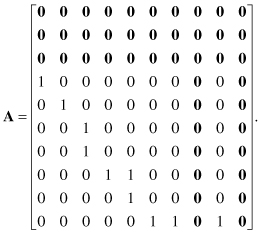8.4 FORMAL TECHNIQUE FOR ANALYZING NSPAs
In this chapter, we will show that representing an algorithm by a DG is suitable only when the number of tasks comprising the algorithm is small. However, it is difficult to extract some of the algorithm properties from an inspection of the graph.
For example, it is simple to find W by counting the number of nodes in the graph. Estimating D is slightly more difficult since it involves path search, while estimating P is even more difficult by inspecting the graph.
We need to introduce a more formal technique to deal with the case when the number of tasks is large or when we want to automate the process of extracting the algorithm W, D, and P parameters. We will refer to the tasks of the algorithm as nodes since that was the term we used in the DG description. The technique we explain here converts the DAG of an NSPA into a DAG for an SPA.
Given W nodes/tasks, we define the 0-1 adjacency matrix A, which is a square W × W matrix defined so that element a(i, j) = 1 indicates that node i depends on node j. The source node is j and the destination node is i. Of course, we must have a(i, i) = 0 for all values of 0 ≤ i < W since node i does not depend on itself (self-loop) and we assumed that we do not have any loops. As an example, the adjacency matrix for the algorithm in Fig. 8.1 is given by
Matrix A has some interesting properties related ...
Get Algorithms and Parallel Computing now with the O’Reilly learning platform.
O’Reilly members experience books, live events, courses curated by job role, and more from O’Reilly and nearly 200 top publishers.


